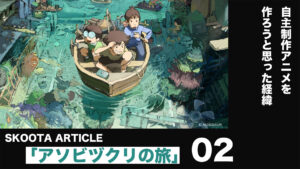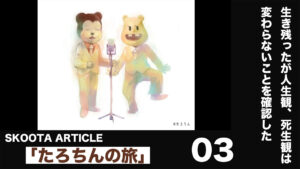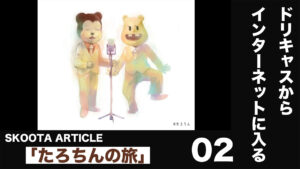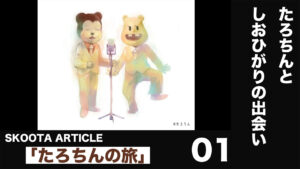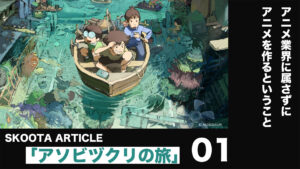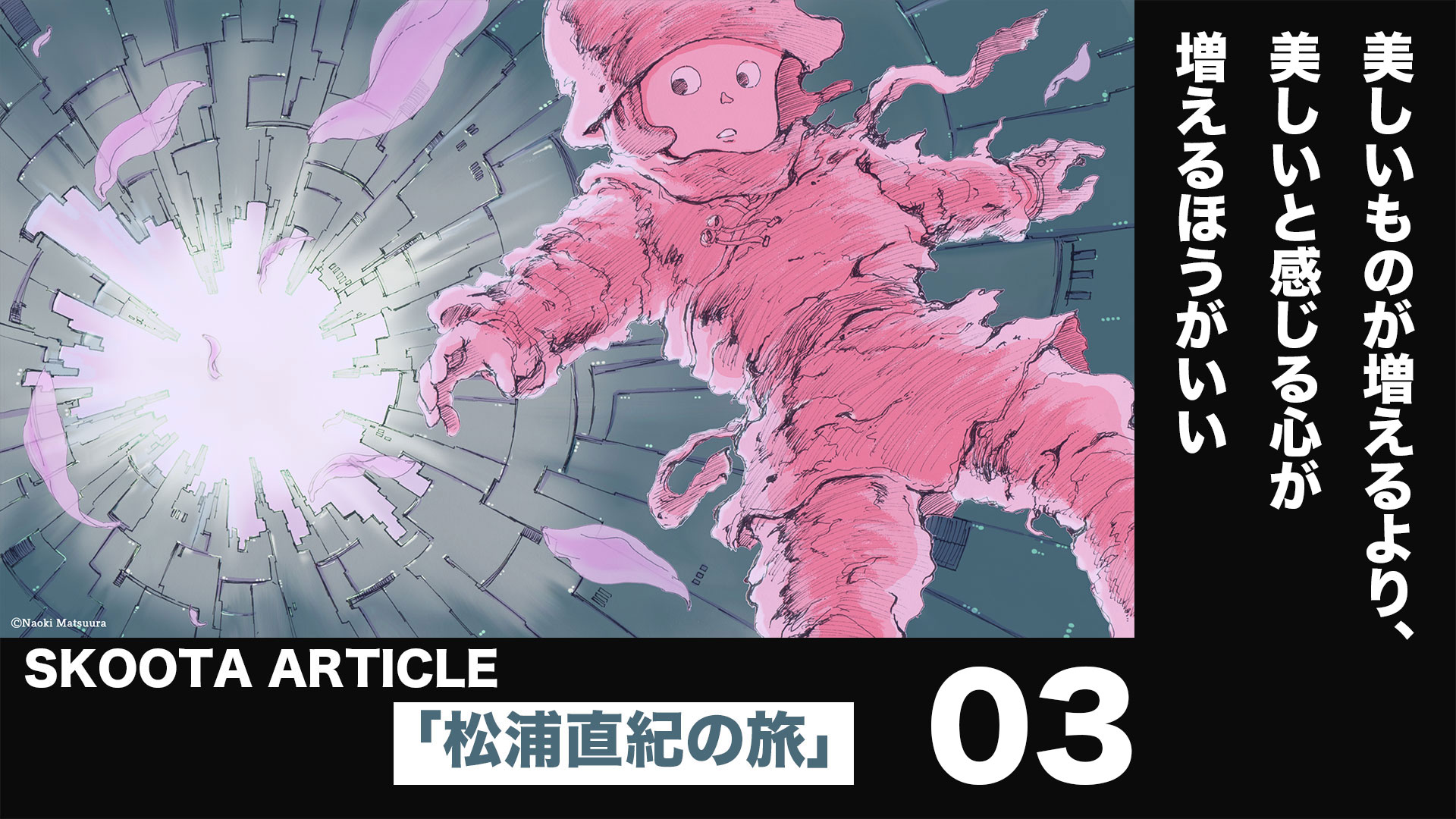
Guest, Personality
Guset:Naoki Matsuura
Currently active as an animation director, director, and animation creator
Member of the Japan Animation Association
Born in Tokyo in 1982, currently residing in Kanagawa Prefecture. Graduated from the Department of Imaging Arts and Sciences at Musashino Art University in 2006.
After working as a production assistant at Polygon Pictures, Production I.G, and ROBOT, among others, he became independent. He has experience in producing various types of visual and animated content, including TV, commercials, music videos, exhibitions, and live visuals. In 2016, he directed the exhibition video for the Japan Pavilion at the Milan Expo, and the project won a gold medal at the Expo. His first work as an animation director for a commercial project was the “Marukome Miso Animation CM.” Since then, he has also worked on storyboarding and directing TV series animations.
In 2016, he conducted crowdfunding for his original short film “Hizukuri,” raising over 1.7 million yen. The film was completed in 2021 and has been screened at events, distributed online, and submitted to film festivals, receiving nominations and awards both domestically and internationally.
In 2023, he directed the TV anime “Liar Liar.” Currently, he is directing a feature-length animated film scheduled for release in 2024.
Personality: Yuuki Sakoda
After working for a telecommunications company and a comprehensive advertising agency, he started an anime planning and production company and produces music videos and films. In 2021, he moved to Kyoto and started working on promoting the entertainment industry in Kyoto. He is currently also working in the entertainment field of manga and audio. He is planning and producing audio dramas and webtoons. In addition, he serves as a producer and advisor for multiple entertainment companies.
About Hidukuri
Sakoda
This is a brief recap of our discussion so far. We’ve been hearing a lot of anecdotal stories about people you met while working at various companies and in different settings after you started your career. Listening to stories about Satoshi Kon and Mamoru Oshii, among others, has given us a clearer picture of your current role as a director. Through these numerous encounters and various good and bad experiences, you’ve now arrived at a point where you are working on a feature film as well as directing a TV anime series.
You created an independent project called “Hizukuri,” which was completed successfully through crowdfunding. I’d like to hear more about the release plans and any episodes related to “Hizukuri.” I also have experience using crowdfunding for a project. How was your experience? Would you prefer to start by discussing the project, or would you like to talk about the crowdfunding process? Where do you think we should start?
Matsuura
Let’s start by talking about the project.
Sakoda
By the way, is it currently available for public viewing?
Matsuura
No, not yet.
Sakoda
I see. So, for those listening who haven’t seen it yet, they might get a different perspective when they do have the chance to watch it. The story is about a scissor craftsman. This theme and the details are described in the book created during the crowdfunding campaign. I find it quite intriguing and profound. Could you tell us more about why you chose this theme and what you wanted to convey through “Hizukuri”?
Matsuura
To explain briefly for those who don’t know, there is a real-life scissor craftsman named Sasuke in Sakai City, Osaka. The current craftsman, Yasuyuki Hirakawa, is the fifth generation in his family, which has been making scissors since the end of the Edo period. I first visited Sasuke’s workshop through a friend from university who was working there. The first time I used one of their scissors, I was impressed by the sharpness and thought it would be great to focus on craftsmen like him in animation. That’s how it started.
Sakoda
So, they specialize in scissors?
Matsuura
Yes, they also make knives and other small items like paperweights and candle holders, but they are primarily scissor makers. Historically, they started making scissors after previously making guns and swords. Their ancestors ran a maritime business selling goods, but eventually, they shifted to making scissors.
Sakoda
Sakai is known as a merchant city. We haven’t talked much about your production process in past episodes, so I’d like to dive into that as well. The blacksmithing scenes in “Hizukuri” are especially impressive. Could you share some memories or thoughts on these scenes?
Matsuura
There’s so much to talk about regarding “Hizukuri.” For the blacksmithing scenes, I was heavily involved in the effects and animation, even doing some of the final touches myself. Since I was the sole producer and director, I handled everything, including financial and data management. I initially planned to outsource more work to friends and acquaintances, but in the end, I realized I needed to do it myself to be satisfied.
Sakoda
It sounds like you put a lot of effort into perfecting those scenes.
Matsuura
Yes, it took a long time to finalize those scenes. I kept asking for more time from our supporters and kept extending the deadline. Originally, we aimed to complete it by the end of 2017, but it took three more years. Despite the delays, I felt that the time spent was necessary to achieve the desired quality. Seeing the results at film festivals and getting feedback was very rewarding.
Sakoda
I’m particularly interested in the involvement of UQiYO in this project. It’s a fascinating collaboration. Music plays a significant role in enhancing the depth of the work.
Matsuura
Yes, UQiYO’s involvement started when I heard their song “TWiLiGHT” on the radio. I felt an instant connection, like they were heading in the same direction as me. I followed their activities closely and eventually reached out to collaborate on this project.
Matsuura
The music video for ‘TWiLiGHT’ was also amazing. I actually visited the office of Tsuge-san, the director of the music video, and interviewed him for about one or two hours, asking all sorts of questions like, “Where did you shoot this?” “How did you choose the cast?” and “How did you handle the costumes?” I learned a lot from him.
Matsuura
I remembered a lot of what I learned from that interview. When I decided to start working on ‘Hizukuri,’ I thought, “These guys would be perfect for the music.” So, I wrote a very long email introducing myself, explaining that I was working on an independent project funded through crowdfunding, and asked if they could create the music. That’s how our collaboration began.
Sakoda
In the interview with Yuqi from UQiYO, he mentioned receiving a passionate message from you. It must have been fun to collaborate with them. However, even if you like someone’s work a lot, taking the first step to reach out can be difficult. He said it’s rare to receive such emails. Did Yuqi visit Sasuke-san with you?
Matsuura
Yes, we recorded sounds and talked there. As a surprise, I invited my friend Aoi-san, and we all had dinner together. At that time, UQiYO was an indie band, but they had a music producer, and we exchanged opinions with him. During the crowdfunding period, I coordinated with their nationwide tour and promoted the crowdfunding campaign at their live shows. They announced it during their MC segments, and I printed flyers myself to distribute at their booths. We traveled around the country together, handing out flyers. It was a lot of fun.
Sakoda
That sounds amazing. I’d love to do a nationwide tour with artists when I create something next time.
Matsuura
It was really fun.
Sakoda
In visual works, music is a strong element, including sound effects and voice acting. Various sounds come together to form a crucial part of the work. It would be great to have the entire project team on board for a unified vision, but in commercial projects, many decisions are made based on different circumstances.
Matsuura
Yes, that’s true.
Sakoda
So, if we could work together like that, it would be ideal, similar to the partnership between Miyazaki and Hisaishi. But let’s listen to one of UQiYO’s songs we’ve been talking about.
Matsuura
Yes, here is ‘Dry Dry Try’ by UQiYO, the theme song they created for my short animation ‘Hizukuri.’ Please enjoy.
Let’s talk about works and physicality based on the concept of “creating fire.”
Sakoda
Yes, the song you just listened to was “Dry Dry Try” by UQiYO.
Matsuura
Indeed. This song was created after I initially paid for it. The theme of the work resonated deeply with them, and Yuqi-san wrote the lyrics, capturing the protagonist’s emotions beautifully.
Sakoda
At what stage of the project did Yuqi-san begin working on the song?
Matsuura
I don’t think we had a storyboard yet. Initially, I had something close to a complete scenario or plot. Then, I drew many key visuals and sketches, showing them the visual style and world setting. It was like adding ingredients to a simmering soup together.
Sakoda
From Yuqi-san or UQiYO’s perspective, how much information was most helpful for creating the song?
Matsuura
I don’t know how easy it was for them, but they enjoyed the process despite never having worked this deeply with visuals or animation before.
Sakoda
Right. Just as we might not fully understand music, they might not fully grasp animation. But both are media with significant synergy, leading to good collaboration.
Matsuura
Exactly. UQiYO and Yuqi-san’s concepts and values closely aligned with mine and those of the “Hidukuri” project. Their involvement helped raise my visibility since I’m relatively unknown in animation. Touring with them, handing out flyers, and promoting my work at their live shows brought new supporters.
Sakoda
Many music fans are also familiar with animation, so it’s fascinating how these different audiences can be reached.
Sakoda
I’d like to continue discussing the colleagues you’ve met during your production journey. Lastly, let’s discuss the physicality in “Hidukuri.” It’s a work that conveys a strong sense of physical presence, like the hardness of iron and the heat of fire. How do you define physicality in your work?
Matsuura
Ah, this could take two hours, plus another two hours! Well, where to start? In today’s world, visual and auditory senses dominate our experiences. We live through screens and speakers, which means we’re missing out on other sensory experiences. This concern led to the setting of “Hidukuri,” contrasting a mechanized, advanced world with a more analog, wind-powered one. Influences like “AKIRA” and Oshii’s “Ghost in the Shell” also stem from a fear of losing physicality. The visceral experience of using a well-crafted tool, like a pair of scissors, conveys a deep connection to the history and people who created it. This is something unique and tangible.
Sakoda
So, I love this discussion. The idea of creating something enduring resonates with me, especially in contrast to the transient nature of much commercial media. Focusing on physicality and enduring elements can create a deeper connection with both past and future generations. For example, walking on the gravel paths of Kyoto shrines feels like connecting with history through the sensory experience.
Matsuura
It’s interesting how these moments of physical connection can make us feel linked to history and the future. My encounter with Sasuke’s scissors made me realize the importance of creating something that lasts. Unlike transient media, these tools represent a legacy spanning generations. It’s a humbling and inspiring realization.
Sakoda
Exactly. The pleasant sensation of using a well-crafted pair of scissors is just that—a pleasant sensation.
Matsuura
There is a story I’d like to share. One of my university mentors, Oda-sensei, who was an audio director at NHK, introduced me to Aoi-san, who worked at Sasuke. When Aoi-san and I were discussing the crowdfunding for “Hidukuri,” Oda-sensei gave us some advice before we started. He said, “You cut to unite, not to divide.” This phrase really struck me.
Matsuura
Aoi-san started crying when I shared this with him, even though we had been chatting normally. He said, “Yes, that’s exactly it.” It was a touching moment. Oda-sensei’s words beautifully encapsulated the essence of what we were trying to achieve.
Sakoda
The idea that cutting can unite rather than divide is such a powerful expression. It ties into the story of the protagonist in “Hidukuri,” who repairs a broken pair of scissors to mend his strained relationship with his father. This metaphor resonates with my own experiences and the desire to reconcile with my father.
Sakoda
The idea that cutting can unite rather than divide is such a powerful expression. This concept aligns with Buddhist notions that to understand oneself, one must also understand what is not oneself. This relative understanding is essential. The act of cutting, which separates, paradoxically brings a deeper understanding of unity. This perspective deeply enriches the narrative and my own work.
Matsuura
Absolutely. Oda-sensei is so cool, I really admire him.
It is better for the capacity to feel beauty to increase than for the number of beautiful things to increase.
Sakoda
Listening to the episodes of “Hidukuri” now, I hope we can close with the idea that your current position is thanks to the various people you’ve met along the way. But I want to hear more about your team and colleagues, so I hope we can have a second part in the future.
Matsuura
Oh, anytime.
Sakoda
There are so many people, really. I’d love to hear about Kappy-san too.
Matsuura
Ah, Kappy, yes. I’d love to talk about him too. He’s become much more famous than me, which is exciting.
Sakoda
Crowdfunding really requires strong promotional marketing skills, and that’s where Kappy-san comes in.
Matsuura
Right. To explain briefly, at the time, he was starting to become a popular manga artist with “Eren the Left-Handed.” I thought I’d leverage his fame, so I casually asked if he could help. He suggested, “How about writing a story where Matsuura-san appears in Eren?” I thought it was a great idea, and we discussed it over tea. When it came out, the access numbers shot up, bringing in more supporters and giving the project a boost.
Sakoda
That’s fantastic. That’s what crowdfunding is all about.
Matsuura
I can’t thank him enough for that.
Sakoda
I also want to talk about Funakakushi-san and Nakamura-san. Funagakure-san has been making lo-fi hip hop videos for the past two years.
Matsuura
Ah, those directed by Yojiro Arai.
Sakoda
He’s been producing incredibly beautiful background art.
Matsuura
He’s amazing too.
Sakoda
Yes, he lives in Kagawa and has a strong desire to give back to his hometown.
Matsuura
I visited once; it’s a fantastic place.
Sakoda
Is there anything you feel you haven’t talked about enough?
Matsuura
Well, if I tried to cover everything, it would take as long as my life. More seriously, regarding the anime industry and the various social and business issues, at the root, like my interest in Sasuke’s scissors, there’s a kind of curiosity or a receptive mind. It’s essential to have that feeling of “Oh, this is interesting.”
Matsuura
Oh, and one more episode. There’s a designer I admire, Yoshiaki Nishimura, who wrote on his blog about a beautiful sunset in the mountains. He stopped his car to admire it, and a few others did the same. They watched the sunset, and once it disappeared, everyone got back in their cars and left. He wrote about this experience on his blog.
Matsuura
He wrote, “Isn’t it more important to have more hearts that feel beauty than to have more beautiful things?” I thought it was a wonderful sentiment. While I keep creating more works, I believe just watching a sunset and thinking, “That’s beautiful” is also a profoundly creative act. I want my works to be like that sunset, something people can look at and simply think, “That’s beautiful.” I create my works with that wish and prayer, and I’m working hard to make my current projects reflect that.
Sakoda
So, we’ll be able to see your current work in a movie in 2024?
Matsuura
Yes, if we finish it by next year (laughs). This project has substantial funding, so there won’t be any delays like with crowdfunding. We face many challenges daily, with long meetings to discuss various issues. But at the core, it’s about feeling beauty and love. Although “love” might not fully capture the sentiment, it’s about going with what feels right. Money, time, environment, and conditions matter, but fundamentally, as Nishimura-san’s story illustrates, just feeling the beauty of a sunset can be enough. If we have that heart, everything else will follow. I hope for a world like that.
Sakoda
No, no, the last story really needs to be left as it is, without any reinforcement. It’s something people will understand in their own time. If someone isn’t ready to understand it now, they won’t. This is a story to let settle in the heart, to be felt when the time is right. Thank you for the wonderful conversation.
Matsuura
Thank you for listening.
Sakoda
But I’m amazed that a director working on a major, capital-intensive theatrical project can still talk so emotionally in the midst of it. It’s surprising.
Matsuura
I think I’m pretty thick-skinned. Plus, I’m quite insensitive—I forget all the bad things once I sleep (laughs). I try not to accumulate stress. There’s no end to bad things or frustrations, so I don’t waste time on them. Life is too short for that.
Matsuura
It’s better to enjoy myself because it makes the people involved happier too. Like Oshii-san, whom I admire. When he says something, everyone just accepts it, creating a pleasant and cooperative atmosphere. As a director, I want to create a good atmosphere on set, make it a comfortable place.
Sakoda
This connects to what I was thinking: directors who have experience with live-action filming seem to have a sense of physicality. Of course, there’s a negative side to that athletic, team spirit mentality—there can be hard parts in human relationships.
Sakoda
But if both you and your counterpart can physically smile and feel good, that’s more important than verbal explanations. I think it’s about what the body feels. Oshii-san has done a lot of live-action work too. Maybe he’s naturally learned to stay happy and maintain that physicality.
Matsuura
Yes, I’ve never seen him irritated. He always seems to be having fun. It’s enviable.
Sakoda
Digitalization, especially in anime, has many benefits, but on the downside, it can dilute the sense that real, flesh-and-blood people are creating the work. When working remotely, you might only feel the physicality of sitting in front of a glowing screen. This efficiency can make it harder to stay happy in the production process. I hope you can happily create your upcoming work for next year’s release.
Matsuura
Yes, I’ll do my best.
Sakoda
Thank you for spending so much time with us today. I hope you can come back around the time of the 2024 release to talk more.
Matsuura
Sakoda
Thank you for coming, Naoki Matsuura-san.
Matsuura
Thank you.

